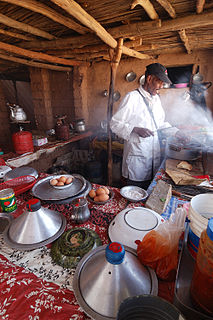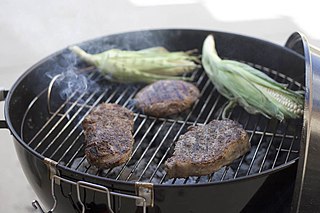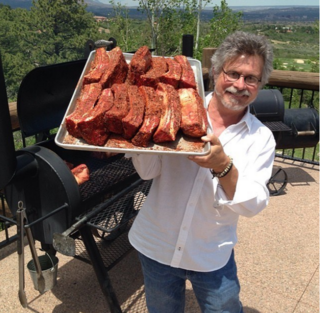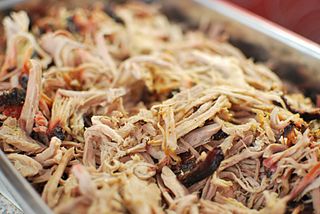
Cooking or cookery is the art, science and craft of using heat to prepare food for consumption. Cooking techniques and ingredients vary widely across the world, from grilling food over an open fire to using electric stoves, to baking in various types of ovens, reflecting unique environmental, economic, and cultural traditions and trends.

Barbecue or barbeque is a cooking method, a cooking device, a style of food, and a name for a meal or gathering at which this style of food is cooked and served.

Grilling is a form of cooking that involves dry heat applied to the surface of food, commonly from above, below or from the side. Grilling usually involves a significant amount of direct, radiant heat, and tends to be used for cooking meat and vegetables quickly. Food to be grilled is cooked on a grill, using a cast iron/frying pan, or a grill pan.

Roasting is a cooking method that uses dry heat where hot air covers the food, cooking it evenly on all sides with temperatures of at least 150 °C (300 °F) from an open flame, oven, or other heat source. Roasting can enhance the flavor through caramelization and Maillard browning on the surface of the food. Roasting uses indirect, diffused heat, and is suitable for slower cooking of meat in a larger, whole piece. Meats and most root and bulb vegetables can be roasted. Any piece of meat, especially red meat, that has been cooked in this fashion is called a roast. Meats and vegetables prepared in this way are described as "roasted", e.g., roasted chicken or roasted squash.

Smoking is the process of flavoring, browning, cooking, or preserving food by exposing it to smoke from burning or smoldering material, most often wood. Meat, fish, and lapsang souchong tea are often smoked.

Outdoor cooking differs substantially from kitchen-based cooking, the most obvious difference being lack of an easily defined kitchen area. As a result, campers and backpackers have developed a significant body of techniques and specialized equipment for preparing food in outdoors environments. Such techniques have traditionally been associated with nomadic cultures such as the Berbers of North Africa, the Arab Beduins, the Plains Indians and pioneers of North America, and have been carried down to and refined in modern times for use during recreational outdoors pursuits.

Brisket is a cut of meat from the breast or lower chest of beef or veal. The beef brisket is one of the nine beef primal cuts, though the definition of the cut differs internationally. The brisket muscles include the superficial and deep pectorals. As cattle do not have collar bones, these muscles support about 60% of the body weight of standing or moving cattle. This requires a significant amount of connective tissue, so the resulting meat must be cooked correctly to tenderise it.

A barbecue grill is a device that cooks food by applying heat from below. There are several varieties of grills, with most falling into one of three categories: gas-fueled, charcoal, or electric. There is debate over which method yields superior results.

Asado is the technique and the social event of having or attending a barbecue in various South American countries, where it is also a traditional event. An asado usually consists of beef, pork, chicken, chorizo, and morcilla which are cooked on a grill, called a parrilla, or an open fire. Generally the meats are accompanied by red wine and salads. This meat is prepared by a person who is the assigned asador or parrillero.

Rotisserie, also known as spit-roasting, is a style of roasting where meat is skewered on a spit – a long solid rod used to hold food while it is being cooked over a fire in a fireplace or over a campfire, or roasted in an oven. This method is generally used for cooking large joints of meat or entire animals, such as pigs or turkeys. The rotation cooks the meat evenly in its own juices and allows easy access for continuous basting.

Barbecue varies by the type of meat, sauce, rub, or other flavorings used, the point in barbecuing at which they are added, the role smoke plays, the equipment and fuel used, cooking temperature, and cooking time.

The following outline is provided as an overview of and topical guide to food preparation:

Steven Raichlen is an American culinary writer, TV host, and novelist.

Spice rub is any mixture of ground spices that is made for the purpose of being rubbed on raw food before the food is cooked. The spice rub forms a coating on the food. The food can be marinated in the spice rub for some time for the flavors to incorporate into the food or it can be cooked immediately after it is coated in the rub. The spice rub can be left on or partially removed before cooking.

Beer can chicken is a barbecued chicken dish and method of indirect grilling using a partially-filled can of beer that is placed in the chicken's cavity prior to cooking. The process is meant to add moisture to the dish, and some believe that steam from the beer serves to steam the chicken from the inside and add flavor to the dish. Some people are avid proponents of the dish, while others have contended that the efficacy of using the beer is overrated, and that the science regarding beer can chicken is debatable. It has been suggested that the dish possibly originated in the U.S. state of Louisiana.

Barbecue chicken consists of chicken parts or entire chickens that are barbecued, grilled or smoked. There are many global and regional preparation techniques and cooking styles. Barbecue chicken is often seasoned or coated in a spice rub, barbecue sauce, or both. Marinades are also used to tenderize the meat and add flavor. Rotisserie chicken has gained prominence and popularity in U.S. grocery markets. Barbecued chicken is one of the world's most popular barbecue dishes.

Barbecue is an important part of the heritage and history of the U.S. state of North Carolina. It has resulted in a series of bills and laws that relate to the subject, and at times has been a politically charged subject. In part, this is due to the existence of two distinct types of barbecue that have developed over the last few hundred years: Lexington style and Eastern style. Both are pork-based barbecues but differ in the cuts of pork used and the sauces they are served with. In addition to the two native varieties, other styles of barbecue can be found throughout the state.

Memphis Wood Fire Grills is a privately held North American manufacturer of pellet grills and food-grade hardwood pellets.




















